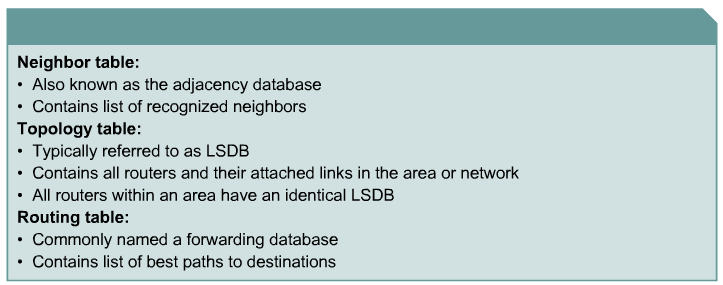Pederrs CCNP 1
Contents
Module 1: Scalable Network Design
Forkortelser:
ECNM = Enterprise Composite Network Model
NAC = Network Access Control (NAC) and
IBNS = Identity Based Network Services (IBNS)
Module 2: EIGRP
Forkortelser:
DUAL = Diffusing Update Algorithm (DUAL)
PDM = Protocol-dependent modules (PDMs) are responsible for network layer protocol-specific requirements. EIGRP supports IP,AppleTalk, and Novell NetWare. Each protocol has its own EIGRP module and operates independently from any of the others that may be running.
RTP = RTP is responsible for guaranteed ordered delivery and reception of EIGRP packets to all neighbors. RTP supports intermixed transmission of multicast and unicast packets. For efficiency, only certain EIGRP packets are transmitted reliably.
SRTT = (smoothed round-trip time): Average number of milliseconds it takes for an EIGRP packet to be sent to this neighbor and for the local router to receive an acknowledgment of that packet. This timer determines the retransmit interval, also known as the retransmission timeout (RTO).
RTO = (retransmission timeout): Amount of time, in milliseconds, that the router waits for an acknowledgment before retransmitting a reliable packet from the retransmission queue to a neighbor. If an EIGRP update, query, or reply is sent, a copy of the packet is queued. If the RTO expires before an acknowledgment is received, another copy of the queued packet is sent.
SIA = stuck in active (SIA)
LSDB = link-state database (LSDB)
SPF = Shortest Path First (SPF)
Module 3: OSPF
Forkortelser:
Teori
3.1.1 Link State Routing Protocols
3.1.3 Link State Data Structures
3.1.6 Types of OSPF Routers
The four different types of OSPF routers are:
- Internal routers: Routers that have all their interfaces in the same area and have identical LSDBs.
- Backbone routers: Routers that sit on the perimeter of the backbone area and have at least one interface connected to area 0. Backbone routers maintain OSPF routing information using the same procedures and algorithms as internal routers.
- Area border routers: Routers that have interfaces attached to multiple areas, maintain separate LSDBs for each area to which they connect, and route traffic destined to or arriving from other areas. Area border routers (ABRs) are exit points for the area, which means that routing information destined for another area can get there only via the ABR of the local area. ABRs can be configured to summarize the routing information from the LSDBs of their attached areas. ABRs distribute the routing information into the backbone. The backbone routers then forward the information to the other ABRs. In a multiarea network, an area can have one or more ABRs.
- Autonomous System Boundary Routers: Routers that have at least one interface attached to an external internetwork (another autonomous system), such as a non-OSPF network. Autonomous system boundary routers (ASBRs) can import non-OSPF network information to the OSPF network and vice versa; this process is called route redistribution.


